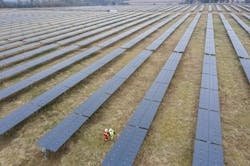Silicon Ranch contracts Black & Veatch to build 125-MW Solar array in Georgia
Solar power producer Silicon Ranch Corporation has selected Black & Veatch to build a 125 MWAC solar array in Lee County in southwestern Georgia.
Developer Silicon Ranch Corp.’s new solar farm project will integrate its “regenerative energy” land-management model.
Black & Veatch was selected to handle construction duties for the DeSoto I solar farm in Lee County, Georgia. This model combines solar energy production and regenerative agriculture practices at the same location.
After the construction is complete, the firm will restore the land to a grassland ecosystem, enabling managed sheep grazing using regenerative land management practices.
Silicon Ranch is funding the project. It will own, operate and maintain the project for the long term.
Black & Veatch Senior Vice President of renewable solutions Paul Skurdahl said the project aligns with the firm’s proven record of innovative approaches to supplying clean, affordable energy. It demonstrates how carbon footprints may be reduced without disrupting the environment.
Silicon Ranch Co-Founder and CEO Reagan Farr said, “Thousands of Georgia residents have already helped us build more than a dozen world-class facilities in the region, and we will work with Black & Veatch and our partners in Lee County to recruit local talent for DeSoto I as well.”
About the Author
EnergyTech Staff
Rod Walton is senior editor for EnergyTech.com. He has spent 17 years covering the energy industry as a newspaper and trade journalist.
Walton formerly was energy writer and business editor at the Tulsa World. Later, he spent six years covering the electricity power sector for Pennwell and Clarion Events. He joined Endeavor and EnergyTech in November 2021.
He can be reached at [email protected].
EnergyTech is focused on the mission critical and large-scale energy users and their sustainability and resiliency goals. These include the commercial and industrial sectors, as well as the military, universities, data centers and microgrids.
Many large-scale energy users such as Fortune 500 companies, and mission-critical users such as military bases, universities, healthcare facilities, public safety and data centers, shifting their energy priorities to reach net-zero carbon goals within the coming decades. These include plans for renewable energy power purchase agreements, but also on-site resiliency projects such as microgrids, combined heat and power, rooftop solar, energy storage, digitalization and building efficiency upgrades.
